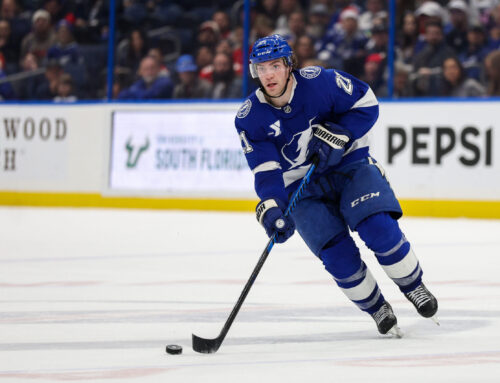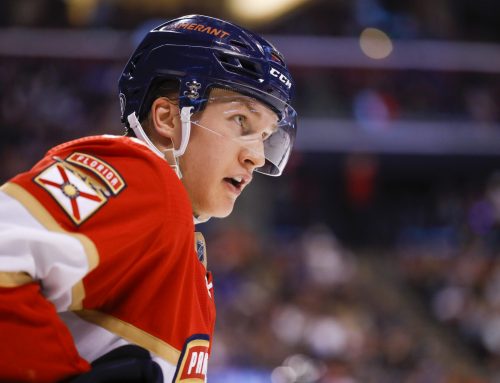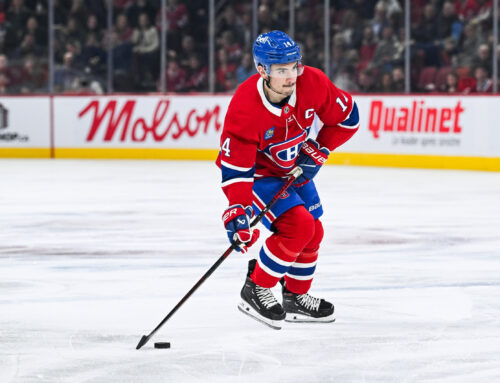
Roos takes a look at declining forwards who should no longer be considered 60-point players
In last week's column, I looked at forwards who should no longer be projected to score 75+ points in a season during their career, as this is a great time of year to identify guys to finally write off as never being able to achieve a certain level of production – what I call the "time to downgrade" guys. There were lots of great comments and good debates in response to last week’s Part 1 article, so hopefully that momentum will carry into this week, when in Part 2 we look at several forwards who should now be ruled out as 60+ point scorers.
In today's fantasy hockey landscape, 60 points is an important threshold, since for most leagues it represents someone who's generally productive enough to leave in your line-up on a daily basis throughout the season. It might be tempting to think you don't have to focus too much on this level of player, but remember that at the end of the day it's just as bad to have a guy you counted on to score 60+ points only end up with 45-50 points as it is for a 75+ point guy to only give you 60-65 points. So it's important to identify – and avoid – players like the six discussed below.
Forwards who will never be 60+ point producers
It's impossible to ignore how hot the Winnipeg top line of Andrew Ladd, Blake Wheeler, and Bryan Little were in the last quarter of this abbreviated season. I'll be honest in that I've never been a fan of Little, but even I was genuinely surprised to see that despite the remarkable success of the other guys on the line (Ladd in the top 20 of league scoring, Wheeler in the top 30), Little has yet again underperformed by finishing the season with a mere 32 points in 48 games, which has him down around 75th in league scoring and projects to a pace of only 55 points over a full season.
It's not an exaggeration to say that Little's situation in Winnipeg literally could not have been better over the past two seasons. This year in particular he's playing just under 20 minutes per game, with over 60% of his even strength shifts with Ladd and Wheeler (and over 15% with just Ladd) according to Frozen Pool, plus 2:32 on the power play per game, with about 90% next to Ladd (60% with Ladd and Wheeler). His spot is arguably as good as (if not better than) it was for other guys like Scott Hartnell and Alexander Burrows, who were "along for the ride" with other top scorers in past years; yet each of them managed to get 67 points in a season, while Little has shown no signs of achieving anything close to that. The reality is that even though Little is still only 25 years old, given what we've seen it's just not reasonable to ever project him doing better than 55 points.
Bozak's situation is almost identical to Little's in that he lines up with the very best Maple Leaf forwards, yet somehow doesn't put up points. Looking again at Frozen Pool, Bozak has played more than 75% of his even strength shifts with either Phil Kessel and James Van Riemsdyk or Kessel and Joffrey Lupul, and virtually all of the rest of his even strength time with one of those three. The same is largely true on the power play. And in terms of ice time, Bozak gets more PP minutes (right around 3:00 per game) than any Leaf forward other than Kessel, and the most overall ice time (by over 30 seconds) of any forward on the team.
Despite all this, Bozak is astonishingly faring even worse than Little by somehow scoring at a pace that projects to barely 50 points. It almost defies logical explanation. But the great news is we don't have to explain it – we just need to realize what's now clear, which is that we simply have to write Bozak off as ever being a legitimate candidate for 60 points. What's even worse is Bozak has been unable to raise his point scoring pace even though he's set to become a UFA this summer, and he could very well find himself in a less favorable offensive situation on a new team next season. In fact, because of what he's done this campaign, and since he's never even recorded more than 47 points in a full season, the best move if you own Bozak is to find a good time to trade him before next season starts.
Let me start by saying hats off to forum member rataylor22, who correctly pegged Stafford as a guy who would be included in this week's Part 2 column. But back to Stafford – poolies who had been patient with him in his early years were thrilled when he emerged with 52 points in 62 games (just under a 70 point full season pace) during the 2010-11 campaign. And although he slipped to 50 points in 80 games last season, he ended on a torrid pace of 17 points in his final 13 games while on a line with Tyler Ennis and Marcus Foligno.
Not surprisingly, expectations were set pretty high for Stafford this season, but he's simply looked flat and unskilled. To put his scoring woes of this season into perspective, he'd actually find himself outside of the top 40 in defensemen scoring! In fact, Stafford's play has been so poor that it's dragged down the production of Tyler Ennis, who lines up with Stafford on over 50% of Stafford's even strength shifts according to Frozen Pool.
Even if Stafford manages to stay in the Sabres top six (and that might be a big "if") next season, there doesn't seem to be any realistic hope that he'll bounce back to flirt with the 60 point threshold given how far he's fallen. And what's worse is he's doing so poorly now that you probably can't even trade him in your league, so my advice is stash him on your bench if you can, on the off chance that he rebounds somewhat next season, or drop him without hesitation if you need to make room for someone – nearly anyone – else.
Just when people were starting to write off Dubinsky after he slumped to 34 points in 77 games in 2011-12 for the Rangers (he'd scored 98 in 146 in the two previous seasons, which projects to a 55 point pace), he was included as a key piece in the trade that brought Rick Nash to Manhattan. All of a sudden, folks were thinking of jumping back on the Dubinsky bandwagon in hopes that he'd be a focal point of the Blue Jackets offense.
Although Dubinsky has performed moderately well in Columbus (slightly above a 50 point pace in an injury shortened season), it now seems pretty clear that he just isn't cut from the right cloth to be a 60 point guy. Instead, the Blue Jackets see him as a defensive minded player who can allow his more offensive linemates (like Cam Atkinson) to take chances and focus on scoring. Staying in that role will allow Dubinsky to compile his fair share of points here and there, but not above 60. Plus, although he's getting just under two-and-a-half minutes of PP time per game, it's clearly second unit duty. And as was the case with Jordan Staal, who I discussed last week in Part 1, Dubinsky's point output will also be hampered by the fact that he's tasked with even more time per game on the penalty kill, and that will take a lot of the offensive pop out of any player (more on this below in my Final Verdict).
After Callahan climbed to 54 points in only 71 games last season (projecting to 62 points over a full season), many thought he had emerged as the best of the league's multi-cat superstars, eclipsing even Dustin Brown and David Backes when factoring in points, hits, and blocked shots. Fast forward to this season, and although Callahan has remained healthy and is again among the leaders in combined hits and blocked shots for forwards, his point scoring pace is down by about 15%.
So what happened? The Ranger offense has slumped somewhat (around 2.65 goals per game, from just over 2.75 last season) and Callahan's shooting percentage is down slightly. But on the other hand, more than 55% of Callahan's even strength shifts (and a similar percentage of his power play time) has been alongside the Rangers' best offensive player – Derek Stepan. I think that what it boils down to is that Callahan and the Rangers see his main benefit to the team as coming in the form of hits, blocked shots and other things that don't translate to points. As long as Callahan (and the Rangers) feel that he's better off not concentrating on point scoring first and foremost, chances are that his points ceiling will stay in the low to mid 50s.
Patrik Berglund
There were high hopes for Berglund this season, especially since his previous "bad year, then good year" pattern meant he might be due for nice points numbers this campaign. Plus, even though he managed only 38 points last season (less than half a point per game), he had two good scoring streaks in the final third of the season (seven points in seven games, then another separate streak of six points in six games). But he's been unremarkable this season, scoring at a 0.5 point per game pace and leaving his fantasy hockey owners low on patience.
Like Callahan, Berglund's issues can't be blamed on his linemates, as he's getting most of his time alongside Chris Stewart, who's been the best Blues forward this season. Berglund is also getting as much PP time as Stewart, and although he received more PP time in his 52 point 2010-11 season, his overall ice time this season is almost identical to what it was during that campaign and puts him fifth among all Blues forwards this year.
I think this is just a case of another big forward who's been unable to find a way to best capitalize on his size to help get points. Plus, he's playing in a Blues system where there isn't a lot of offense overall, and what little there is gets spread among many forwards. All things considered, and although "big guys" often take longer to break out, Berglund seems a long shot for 60 points, which many still thought was within reach. The only hope would be if somehow he goes to another team as an RFA this summer, but even then it would be a stretch to project him for anything more than 50-55 as a best case scenario down the road.
Final Verdict
When it comes to downgrading players who were thought to be on track to put up 60+ points, look for guys in situations like Bozak and Little. Although it's true that there are only so many points to go around on teams, when you're on a line with top 30 scorers you should be able to end up with 60 points in a season at some point. If not, then that's a big trouble sign. In other words, if a player's situation couldn't get much better than it is, then by all means don't be afraid to make the determination that he's hit his point ceiling.
That being said, there could be players out there who would do better if put into a situation where they're the ones being counted on for offense, rather than being along for the ride with other offensive studs. But still, that kind of logic can be a big stretch and can burn you in the end, so be sure not to put too much stock into it, especially with older players.
Watch out for teams that have stacked top nines, like Boston, St. Louis and Philadelphia, since with only so many points to go around you could easily have a situation where a player has the ability to get 60+ points, but routinely ends up with less because points are so evenly distributed among everyone. But on the flip side, watch for players who leave these teams to go to other teams that will likely count on them more, as these kinds of players can often explode offensively for their new squads.
One thing most of these six guys have in common is well more than a minute of penalty kill time per game. When you have a good, but not great player, penalty kill time most likely will hurt his output, since it is tiring and, simply put, is time on ice that doesn't normally lead to points. Even though some offensive studs (like Ilya Kovalchuk, Jonathan Toews, and Ryan Getzlaf) and reliable 60+ point guys (Matt Duchene, Loui Eriksson, Ryan Kesler) spend at least 1:30 per game killing penalties, it's reasonable to figure that they too could be more productive overall if they didn't have to log that much shorthanded time. All in all, you should be more open to concluding that an otherwise borderline player is less likely to ever get 60+ points if he's someone who figures to spend a lot of time killing penalties during his career.
One last thing, which I also noted last week – some of you might be reading this and thinking it's too early to write off most of the guys I named, since they could be traded or find themselves in a more favorable situation down the road. Both of those are valid points, but in fantasy hockey you have to plan for the future based largely on what you know now, which is what I did in this article.
I hope you enjoyed the column (and Part 1). I’ll be on vacation when this is posted, so I won’t be able to answer any comments until next week.
Previously, from Holding Court:
| Time to Downgrade | ||
| The Playoff Chase – Fantasy Impact | ||
| What’s got into these guys? | ||
| 5 Huge Deadline Mistakes to Avoid |






 UTA
UTA ANA
ANA MIN
MIN CAR
CAR MTL
MTL NYI
NYI VGK
VGK DET
DET
